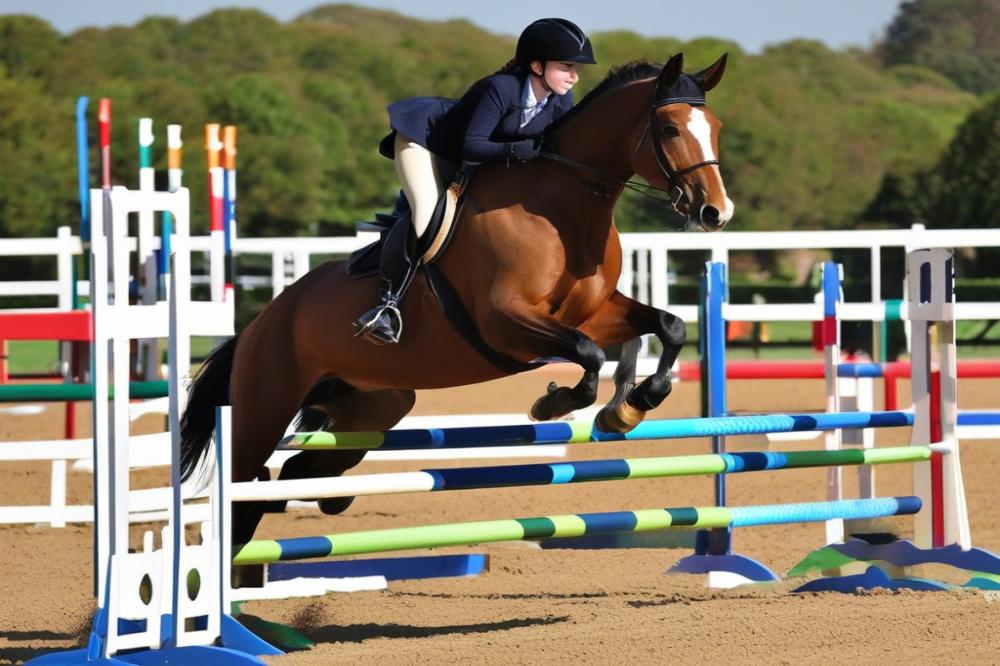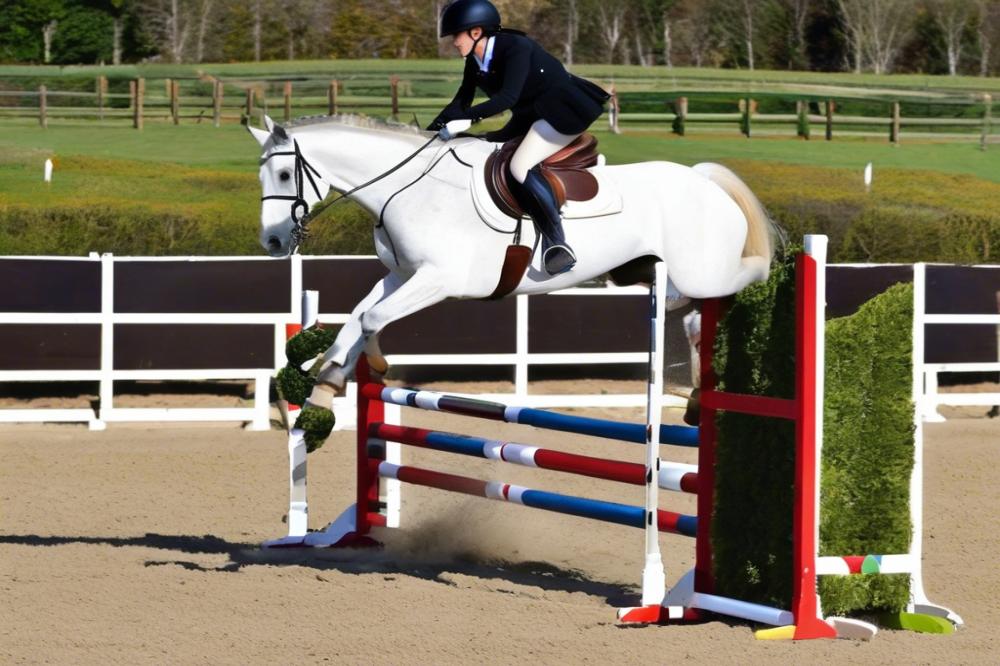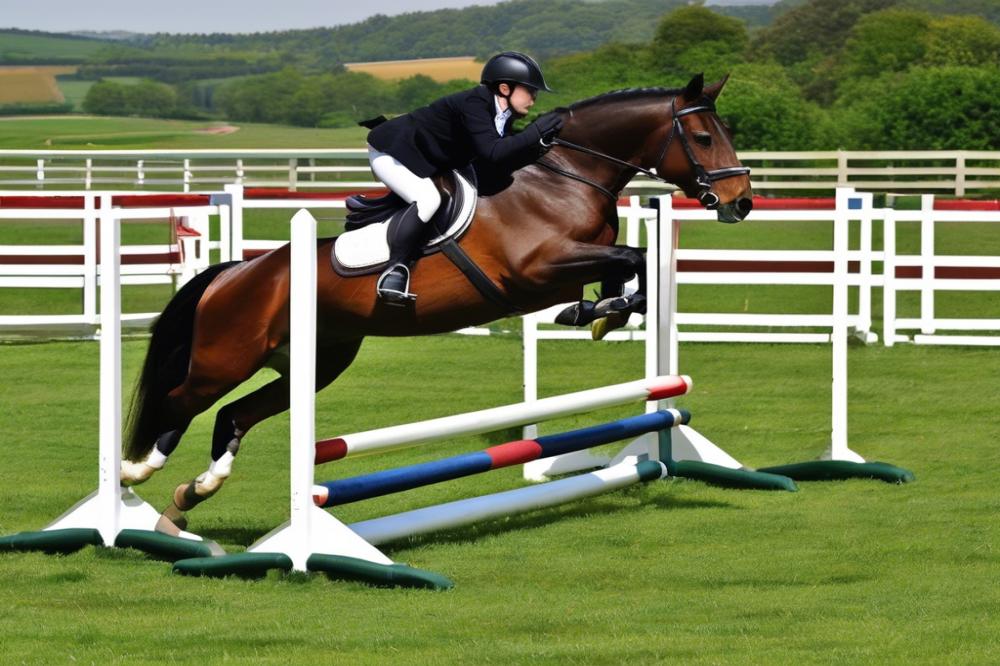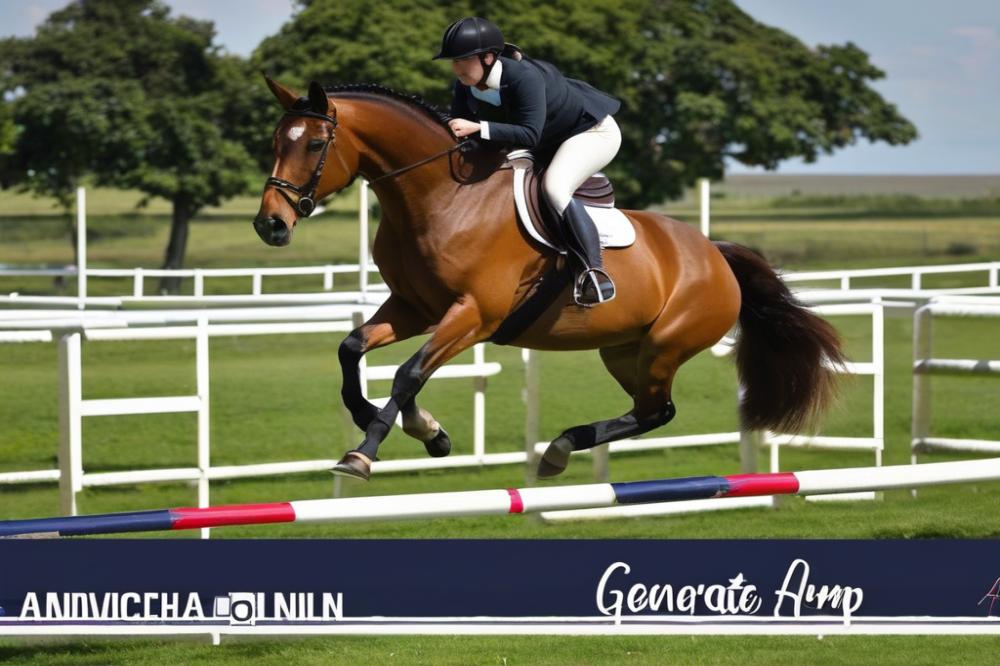Understanding the Art of Jumping
Jumping can feel like a magical dance between horse and rider. In horse training, it plays a critical role, not only enhancing the bond between both parties but also promoting physical fitness and mental skill. Imagine a winged horse soaring over an obstacle, a picture of grace and power! This exhilarating activity can boost a horse’s confidence while also developing the rider’s abilities in a way that’s as fun as it is challenging.
Horse riding goes beyond sitting atop a saddle. It’s a partnership that thrives upon trust and communication. When a horse learns to jump, that bond deepens. Both the horse and rider experience benefits beyond the arena. For the horse, jumping maintains their agility and strength, while for the rider, it hones reflexes and improves overall control. Many would argue that few things are as satisfying as mastering a jump together, like conquering a small mountain as a team.
As we embark on the journey of teaching a horse to jump, it’s essential to remember that success doesn’t happen overnight. Patience becomes your best friend. Starting with basic groundwork is crucial in building a solid foundation. Many jump enthusiasts recall their early days at places like the Camperdown Racecourse, filled with enthusiasm and, yes, the occasional stumble. It’s all part of the learning curve.
Ultimately, the goal of introducing jumping techniques is to create a smooth, enjoyable experience for both horse and rider. This skill not only opens doors to various equestrian techniques but also elevates the thrill of the ride. Whether you aspire to compete or simply enjoy leisurely rides, mastering jumping brings a unique joy that few other horse riding experiences can match.
Understanding Your Horse

Getting to know your horse is the first step in teaching a horse to jump. Start by assessing the horse’s age. Young horses often have boundless energy but may lack focus. On the other hand, older horses can be steady and wise but might be set in their ways. Horse temperament plays a crucial role too. Some animals are calm and collected, while others are spirited and rambunctious.
Next, take a look at the physical condition. A horse that is fit and healthy will naturally perform better than one that is not. Regular vet check-ups are essential. Have they had any injuries? Knowing the history of a horse can help avoid potential jumps that might be too taxing on them. Regular horse care helps maintain a horse’s health for jumping.
Previous Experience
What kind of previous experience does your horse have? If they’ve jumped before, this could make the process smoother. An experienced jumpers might need less time to adjust to new heights and techniques. Conversely, a horse that has never jumped may be nervous about the whole idea. A patient approach towards encouraging a first-time jumper is key.
Start by introducing simple obstacles, and see how your horse reacts. Keep it light and fun! You might have a few nervous moments, but that’s all part of the process. Remember, each horse has its own unique pace when learning equestrian skills.
Building Trust and Communication
Building trust is perhaps the most critical element in horse training. When a horse trusts you, they are more likely to try new things, including jumping. Spend time grooming, and talk to them. Horses respond well to calm and caring voices. Think of it like forming a friendship; the more time you invest, the stronger the bond becomes.
Good communication is equally important in horse riding. Use clear cues and be consistent with your signals. Horses aren’t mind readers, so use your body language wisely. Horses pick up on subtle hints quickly, and having an understanding between you two can make jumping much easier.
It’s all about teamwork. Just like in a dance, timing and rhythm matter. The horse must feel confident with you guiding them through each step. A little humor can go a long way here, too. Sometimes it helps to laugh at the small slip-ups, like when you accidentally trip over a pole while leading your horse! Remember, you’re both learning together.
All in all, understanding your horse is the foundation of any successful equestrian technique. Knowing their strengths and weaknesses allows you to tailor your approach. With patience and practice, you’ll both be soaring over jumps in no time.
Preparing for Jumping Training

Getting ready for jumping training means gathering the right gear. You’ll need jump standards, poles, and safety equipment. Imagine a knight preparing for battle: their armor and weaponry are essential. Similarly, in horse training, your equipment plays a big role in success. Don’t forget a helmet and a good pair of riding boots to protect yourself. It’s always better to be safe than sorry.
Before your horse starts leaping over obstacles, groundwork is vital. This is like laying the foundation of a house. You wouldn’t build a castle on sand, right? Spend time teaching your horse commands and communication skills. Groundwork builds trust, respect, and understanding between you both. It can be a game, too! Just think of it as a dance routine where you both learn to move together. You lead, and your horse follows, forging a deeper connection.
Fitness and conditioning come next on your checklist. A horse needs to be in tip-top shape to handle jumping. It’s not just about jumping over a few poles; it’s about endurance and strength. Picture running a race. Wouldn’t you want to train your body first? Include exercises that improve muscle and flexibility, much like how athletes prepare for their big day. A well-conditioned horse performs better and reduces the risk of injury, making your horse riding sessions enjoyable and safe.
Basic Groundwork Exercises

Groundwork is where it all begins. Many forget that a strong foundation sets up a horse for success in jumping. Focusing on balance and agility is crucial. Each exercise should challenge your horse while keeping it fun.
One exercise you might try is the lateral movement. This involves guiding your horse sideways. Having them move left and right develops body awareness. Use gentle pressure with your hands and legs to encourage movement. Praise them when they respond well. Always remember to be patient; every horse learns at its own pace.
Next, introduce jump poles on the ground. These aren’t just for show; they aid in getting your horse used to the idea of jumping. Start by laying a few poles on the ground in a straight line. Encourage your horse to step over them. Initially, they may just walk or even sidestep. That’s okay! Be supportive and don’t rush the process. As time passes, you can raise the poles slightly to create low jumps. This helps your horse build confidence.
Another significant aspect of groundwork involves desensitization to jumping equipment. Horses can be skittish around new objects. Bringing in standards and decorative jumps helps them adapt. Allow your horse to sniff and explore these items at their own pace. A relaxed horse is more likely to tackle jump training without fear. Use soft-spoken words to reassure your four-legged friend.
Take a moment to play with tarps or flags around the jumps. These items may sound silly, but they are great tools. With time, your horse will stop worrying about all those unusual objects. Instead, they’ll become part of the scenery.
Be sure to keep mixing up your training sessions. Horses thrive on variety. Switching exercises keeps boredom at bay and encourages better learning. After each session, allow your horse to cool down. This is not only good horse care but also builds trust between you two. When your partner trusts you, their willingness to learn improves.
Remember, teaching a horse to jump takes time and effort. Use these groundwork exercises to prepare them for more advanced equestrian techniques. With patience and practice, your horse will build the confidence to soar over jumps.
Introducing Jumping
Introducing your horse to the world of jumping is like teaching a kid to ride a bike. Start small! Tiny jumps, just a few inches off the ground, help build confidence. Think of them as little stepping stones to greater heights. Initially, your horse might look at the jump like it’s a giant monster. One moment, it’s all ears, and the next, it’s doing some impressive acrobatics in the air. Keep the early stages fun and pressure-free. The goal is to instill a positive experience rather than an overwhelming one.
Positive reinforcement plays a crucial role in horse training. Instead of just saying “good boy,” combine your words with treats or a nice scratch behind the ears. Each time your horse jumps successfully, offer a reward. It’s like throwing a party every time they nail it! This reward system builds trust and encourages them to try again. Remember, you want your horse to associate jumping with something pleasurable. Celebrate the small victories; they lead to bigger leaps in confidence and skill.
Approaching that jump correctly is key. Horses can be tricky beasts, and a jump isn’t just a simple hurdle. Think of it as a fun detour in a game. Your horse’s stride matters. Make sure to maintain a good rhythm as you approach. A steady pace helps your horse gauge their distance to the jump. Speed can mess that up. If you rush, you might as well be asking your horse to do an Olympic sprint. Balance and timing are essential. With practice, both you and your horse will find that sweet spot of communication.
As you dive deeper into equestrian skills, remember that each horse is unique. Some might leap over jumps like they have springs for legs, while others may trot cautiously. Tailor your horse care to fit their personality and preferences. Patience is your best friend during this journey. If things don’t go perfectly the first time, that’s okay! Jumping, like learning to ride, takes time and lots of practice. Keep your spirits high, wear a smile, and don’t forget to enjoy the ride.
Developing Jumping Skills
Getting a horse ready for jumping involves more than just the jump itself. It’s a journey that combines horse training, patience, and a touch of creativity. To begin, focus on building a solid foundation with some key exercises. Ground poles are great for improving form. Set them up on the ground and ask your horse to walk or trot over them. This teaches your horse to lift its legs while gaining confidence at low heights.
Simple trot or canter poles can also enhance rhythm and balance. Placing them in various patterns encourages flexibility in your horse’s movements. Don’t forget to reward your horse after each successful pass. It builds trust and reinforces learning in those early stages.
Consistency is Key
During training sessions, remember that consistency is crucial. Horses thrive on routine and repetition. If you train regularly, your horse will start to understand what is expected. Short, focused sessions work best. Aim for around 30 minutes, which helps maintain your horse’s attention without overwhelming it. Mixing up your exercises can keep things fresh and exciting, preventing boredom.
During each session, acknowledge small victories. Horse riding is all about progress, even if it feels slow at times. Celebrate the little milestones. They’ll give your horse the confidence it needs to tackle jumping challenges later on.
Progressive Jumping Challenges
Once your horse has a solid grasp of the basics, it’s time to introduce jumping challenges. Start small and build up gradually. Use cross-rails to introduce the idea of lifting off the ground without too much height. As your horse gets comfortable, you can raise the bars a bit higher. This method helps develop equestrian skills while ensuring your horse doesn’t get overwhelmed.
Another possibility is to introduce different types of jumps, like verticals and oxers. These variations provide new experiences. They keep your horse engaged and excited about going over obstacles. Always prioritize the horse’s comfort. If something seems too challenging, don’t hesitate to scale back. Remember, the goal is to foster a love for jumping, not fear.
Lastly, consider setting up a course with different jumps arranged in a sequence. This creates a mini jumping competition and can be a fun way to end a training session. By making it playful, you spark enthusiasm for jumping. It’s all about building that bond and trust with each jump!
Troubleshooting Common Issues
When it comes to teaching a horse to jump, not everything will go perfectly. Challenges like refusals and lack of confidence can be frustrating. Let’s dive into these common issues and explore some handy solutions. If you’ve ever seen a horse stop short at a jump, you know how disheartening that can be.
Refusal at Jumps
Refusals often happen when a horse feels unsure or scared. Horses are creatures of habit, and they like routine. First, check the approach to the jump. If the horse is rushed, it may lead to a last-minute stop. Connect your reins firmly but relax your shoulders. Sometimes, just a little reassurance from the rider can make all the difference.
You might want to try jumping smaller obstacles. A tiny bar on the ground can help build confidence. If a horse feels that it can clear small jumps easily, it will likely build trust in you and in itself. Gradually increase the height as skills improve. Go slow, like a turtle on a leisurely walk.
Lack of Confidence
Some horses may feel like they wouldn’t even jump over a puddle! This usually means they need positive reinforcement. Speak softly to your horse. Use treats or pats as an encouragement method. A little bit of patience goes a long way here.
Practice makes perfect. You may want to incorporate fun exercises that emphasize movement and play. Play is essential for building confidence. All the equestrian skills you’ll help develop with these exercises will set the stage for more significant successes later.
Patience and Repetition Are Key
Patience is your best friend when training a horse. Jumping isn’t something that can be perfected overnight. Like learning to ride a bike, it takes time! Repetition is equally crucial. Horses thrive on familiarity, like creatures of comfort. Handling a jump multiple times helps solidify that it’s nothing to fear.
Always remember to work within your horse’s limits. Ending a session on a positive note helps to boost confidence. Celebrate small victories! Maybe do a victory lap after a successful jump. Just be sure to treat your horse like the champion it is. After all, patience and kindness make horse training an enjoyable journey for both of you.
Maintaining and Advancing Skills
Regular practice plays a crucial role in sharpening equestrian skills. Just like athletes need to train, horses also benefit from consistency. Think of it this way: if you only play basketball once in a while, you won’t improve much. Practice helps to build muscle memory and confidence, both for rider and horse. Horse training sessions should be engaging and enjoyable. Mixing things up can keep your horse motivated. You wouldn’t want to watch the same movie over and over, would you?
Evaluating progress is essential in any training program. Keep track of what your horse does well and where they struggle. A simple journal can work wonders. Write down the heights they can jump successfully and the skills they’ve mastered. By reviewing these notes, you can set new goals. Start small and then gradually increase the difficulty. Remember, you can’t leap tall buildings in a single bound!
Once you and your horse have nailed the basics, it’s time to introduce some advanced jumping techniques. Think about incorporating different types of jumps, like oxers and water jumps. These add variety and challenge. Advanced courses can be exciting, offering unique challenges. You might even consider participating in a local competition to showcase what you’ve learned. Horse riding becomes a special experience when you push those boundaries together.
Communication with your horse is key. While jumping, you’ll need to work on your cues and timing. This can make all the difference between a smooth ride and a bumpy one. When you notice your horse responding well, it’s a sign of trust and understanding. Gradually, your bond will grow stronger as you tackle more challenging courses.
Finally, don’t forget about horse care. Keeping your horse fit and healthy is vital for their jumping success. Regular vet check-ups, proper nutrition, and a good grooming routine can boost your horse’s performance. After all, you can’t expect a top athlete to perform their best if they aren’t taken care of properly, right? So, treat your equine partner with the utmost respect and care.
Wrapping It All Up
Teaching a horse to jump is quite the adventure, isn’t it? From the very first step to soaring over those fences, every moment creates a story. Let’s recap some essential steps to ensure both rider and horse are on the same page. Start with groundwork; it’s like building a strong foundation for a house. If the horse understands you, the jumping will come more easily. Gradually, introduce obstacles, starting low to build confidence. Remember to use positive reinforcement—no one enjoys being scolded, not even our four-legged friends!
The bond formed between rider and horse during training is truly unique. It’s more than just a partnership; it’s a friendship where trust plays a pivotal role. There’s something special about that moment when your horse, after a little patience and effort, jumps over a hurdle with ease. It’s not just the jump but the journey leading up to it that truly matters. Think of it like a dance; both partners must move in sync to create something beautiful.
As you embark on this exhilarating journey, don’t forget that learning never stops. Continuous improvement not only benefits you but also enhances the experience for your horse. Consider taking lessons or attending clinics focused on techniques and communication. Even seasoned riders find value in fresh ideas, and who knows? You may come across some novel tricks that change everything! And let’s not forget to have some fun along the way. After all, it’s not every day you get a horse licking me while you’re trying to concentrate!
Adding variety into your training can keep things interesting. Perhaps mix in some endurance riding to build stamina and resilience. This helps both you and your horse grow stronger together. Remember, every horse is different, and what works for one might not work for another. Embrace the quirks and let your unique partnership flourish. So grab those reins, keep your spirits high, and enjoy every jump, every stride, and every shared moment out on the field!



